Outside the Lines:
Late paintings of Jean Dubuffet
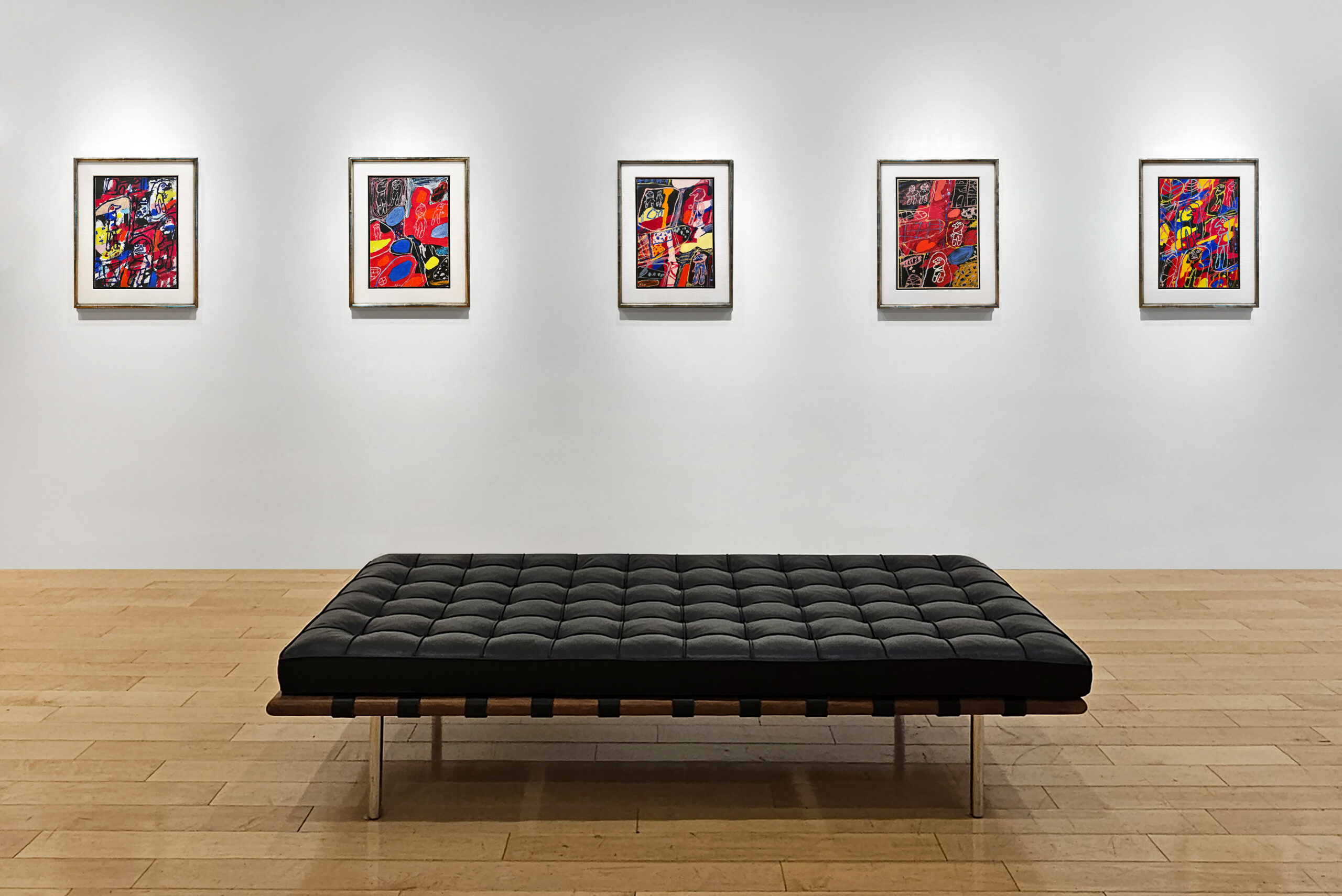
“I am drawn to the art of children and the untrained, as it reflects a pure creativity uninhibited by societal expectations.”
The main focus of our exhibition, Outside the Lines: A Selection of Works by Jean Dubuffet, is a collection of paintings from the artist’s late career known as Psycho-sites. It is useful to learn about the artist’s creative trajectory in order to better appreciate these works and to gain a small bit of understanding about the enigmatic artist himself.
Soon after the outset of his artistic career (at age 41), one of the hallmarks of Dubuffet’s practice became the notion that it was not necessary (or even desired) to follow the “academic” rules of artmaking. Dubuffet rejected conventions, exploring diverse philosophical ideas that shaped his artistic evolution. He transitioned from traditional forms to daring, abstract figures, employing a variety of color palettes from vivid to subdued.
Over the years Dubuffet explored many styles and techniques as evidenced by the massive 38-volume catalogue raisonée of his work known as the fascicules. These books chronicle the many series the artist created and discuss the life events which shaped his thinking as he experimented not only with visual art, but also with poetry, music, and performance art.
The major turning point in Dubuffet’s artistic life came when he traveled to Switzerland in 1945 with Jean Paulhan and architect Le Corbusier. There, he visited a number of psychiatric hospitals and discovered the artistic creations of the patients. As Paulhan wrote, “He ran around the asylums, collecting different drawings and gouaches.” Dubuffet recognized in these works similarities with French cave paintings, street graffiti, tattoos, and other works by children and untrained artists. Collectively he referred them as “Art Brut”, a term he coined to describe works that were created by or drew on the aesthetics of “outsider” artists. He believed these works represented a purer form of artistic expression and his reaction towards them changed the trajectory of his artistic career as it inspired him to take up the continued study and practice of “Art Brut” himself.
Not only was Dubuffet inspired by these “outsider” creations, he also amassed his own collection of these works with the help of Jean Paulhan and the surrealist artist Andre Breton. In 1971, Dubuffet donated these works and they are now displayed at the Collection de L’Art Brut in Lausanne Switzerland. Since its inception, the collection has grown from the 5,000 works in Dubuffet’s initial gift to the 70,000 currently in the collection today.
The painting Trois personnages dans un paysage (below) is an early example of Dubuffet’s Art Brut style and his fascination with the common man in commonplace settings.
“Look at what lies at your feet! A crack in the ground, sparkling gravel, a tuft of grass, some crushed debris offer equally worthy subjects for your applause and admiration.”

Trois personnages dans un paysage, 1957, Gouache on paper
“I am interested in the raw, authentic beauty found in the everyday experiences of ordinary people.”
Dubuffet was more concerned with spontaneity and an emotional connection to the work rather than reason and the traditional “rules” of art. Over the years he experimented with all manner of media from natural elements such as gravel, lava, orange peels, and insect wings to fabricated materials such as polyurethane and polystyrene. He created small works of only a few centimeters to his largest work, Closerie Falbala (also known as Villa Falbala), a kind of “sculptural, 3-D painting” with an area of 1,610 square meters (17,330 square feet) by 8 meters high (26.25 feet). He promoted “instinct, passion, mood, violence, madness”; he preferred spontaneity over the rigors of “classical” art-making.
Dubuffet often chose subjects for his works from everyday life, such as people sitting in the Paris Metro stations or walking in the countryside. The work from the Paris Circus period is a wonderful example of the artist’s spontaneous and playful portrayals of people and objects in day-to-day life. In many cases, people, animals, and objects often became flat and linear as illustrated in the work below, Deux automobiles (Peugeot, Fiat). His viewpoint may have been shaped by his assignment in the French army during World War II when he was posted to the meteorological division atop the Eiffel Tower. The Paris Circus series was also, in part, an expression of Dubuffet’s feelings about capitalism and “conspicuous” consumption.
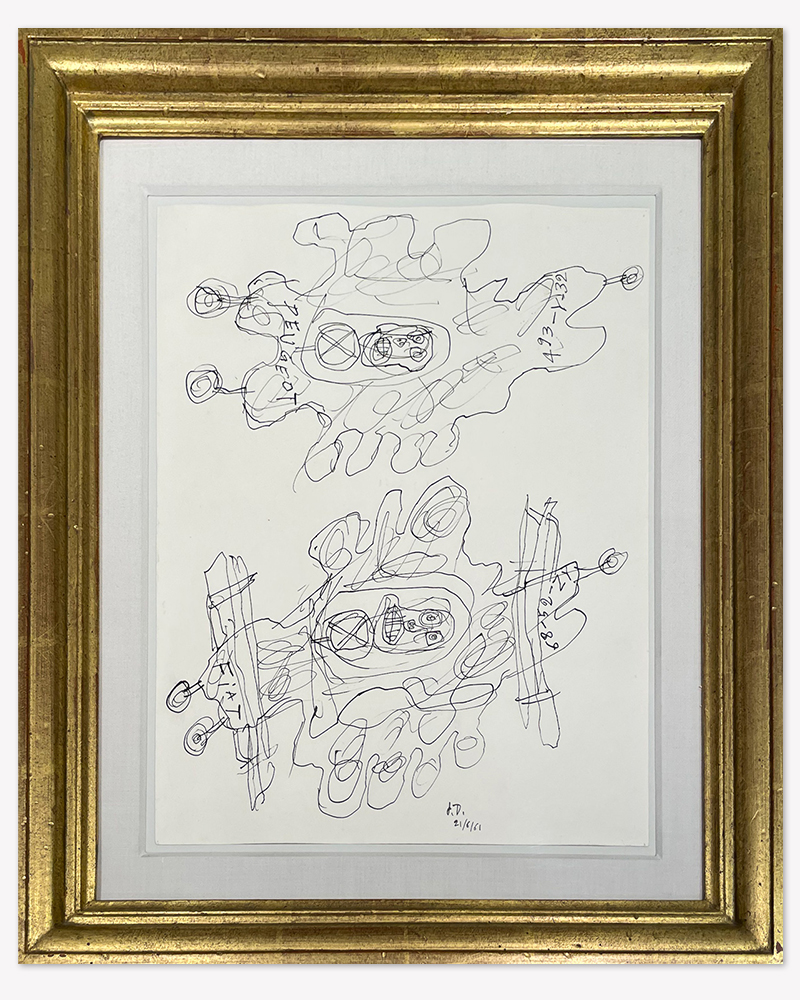
Deux automobiles (Peugeot, Fiat), 1961, Ink on paper
“Art is not about imitating the world, but rather about creating a new reality.”
In his later years, Dubuffet returned to creating work with strong, bold colors and typical imagery that defined the unique style he employed when he first “invented” and embraced “Art Brut”.
These late career creations followed the expansive period of L’Hourloupe which included works depicting walls, trees and architectural elements and works such as Boule Chatourne, juillet 1970, illustrated below. It was during this cycle that he created the expansive Villa Falbala which mimicked, on a large scale, these smaller hourloupe constructions.
The word “hourloupe” is Dubuffet’s invention; the enigmatic artist never explained its meaning. The series origin is quite uncomplicated: it was inspired by some doodles Dubuffet made with ballpoint pens. Despite the inauspicious beginnings, the works from this period are, arguably, the artist’s most enduring and well-known creations.
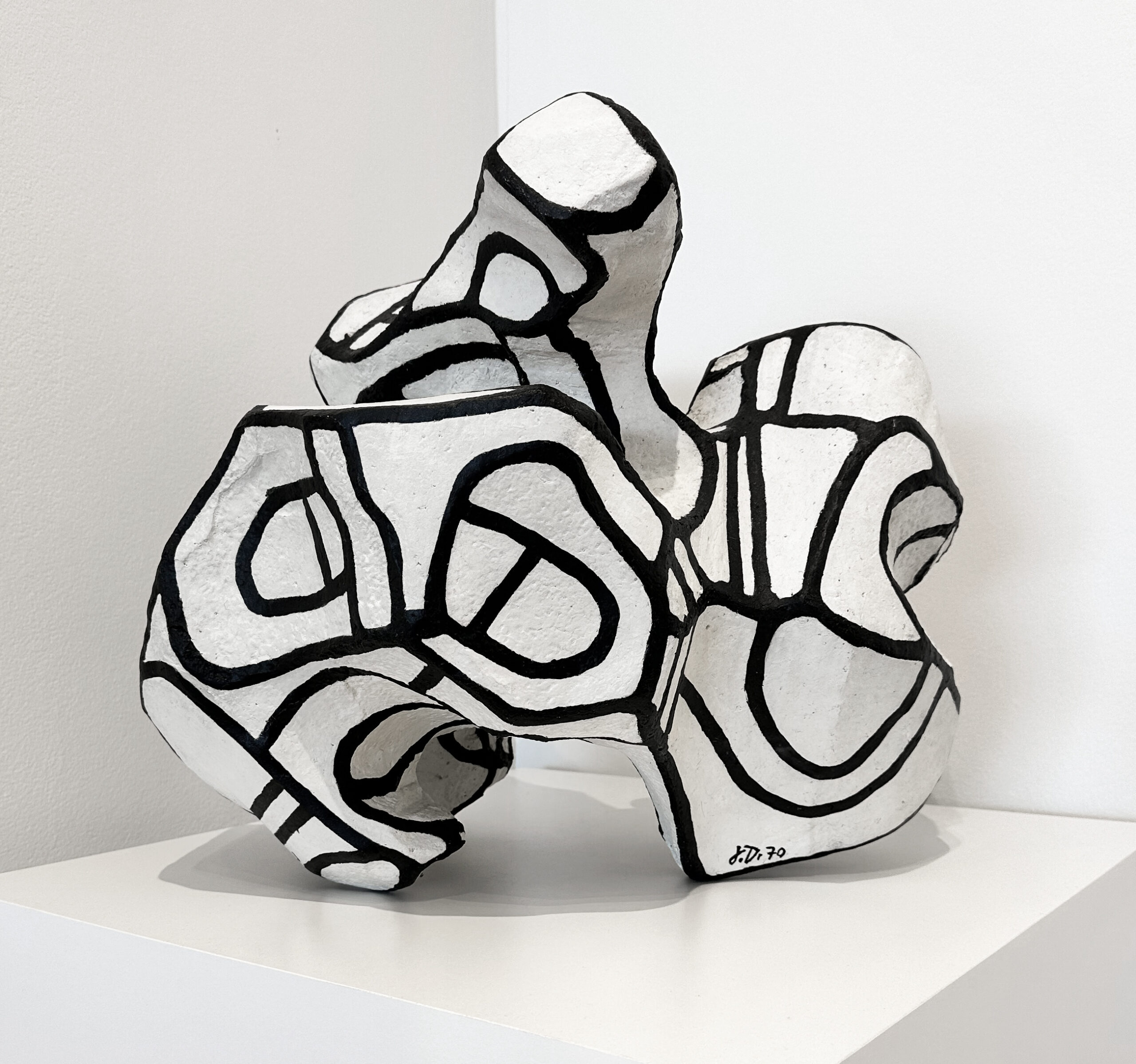
Boule Chantourne, 1974, juillet 1970, Transfer on polyester
“I am interested in the raw, authentic beauty found in the everyday experiences of ordinary people.”
As Dubuffet phased out of the L’Hourloupe cycle (although he still created some monumental works with these themes), his ever-evolving practice turned again to the childlike drawings of an earlier time. In this revisiting of the genre, he chose as his media the instruments of childhood art: crayons, colored pencils, felt-tip markers. Fascicule XXIX from the catalogue raisonée refers to these works as Crayonnages, Rècits, Conjectures.
The subject matter progressed from rudimentary human forms as demonstrated in Paysage à l’automobile rouge (avec 2 personnages mi-corps) below to abstractions which resembled the Hourloupe works, but in 2-D.
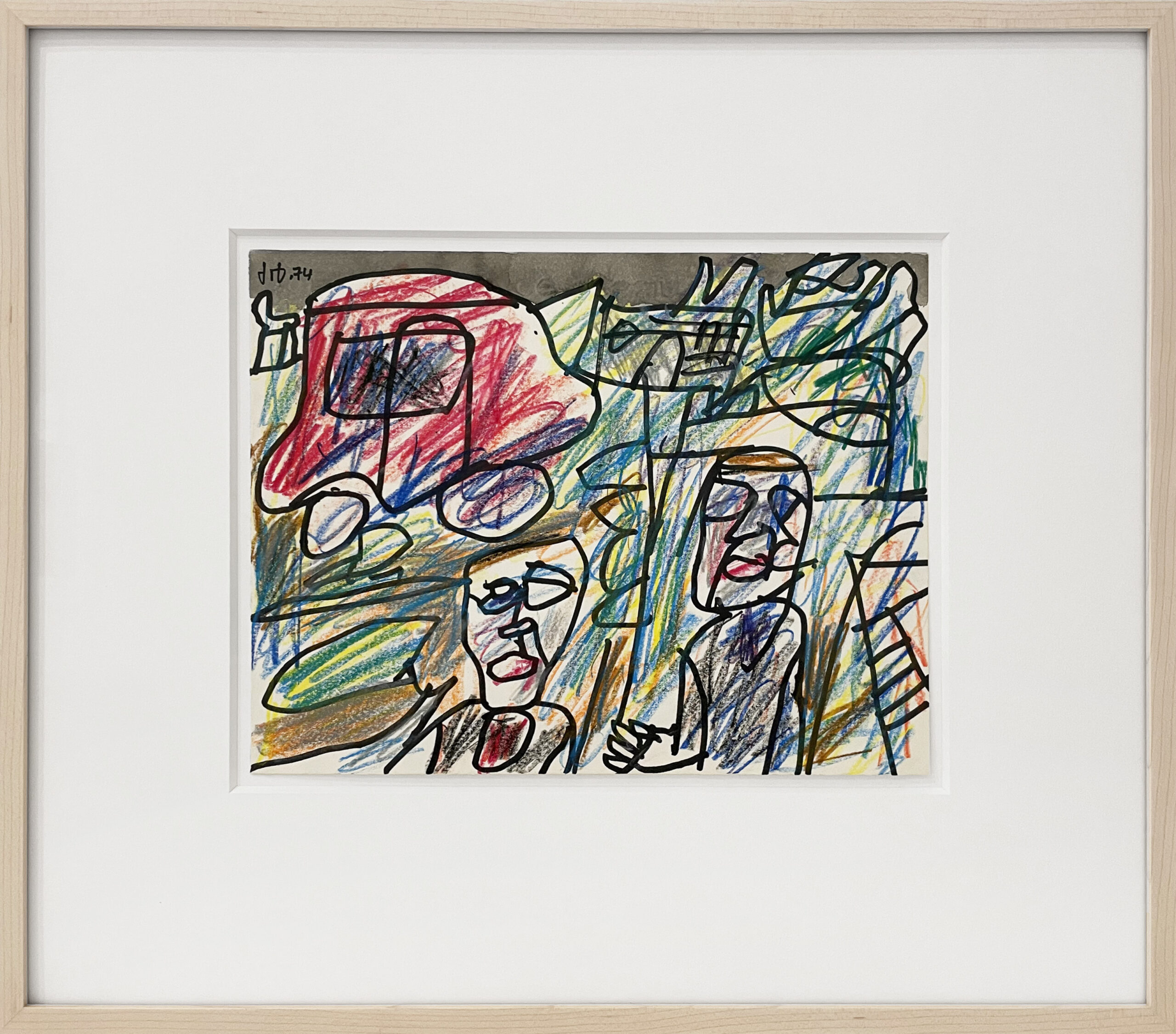
Paysage à l’automobile rouge (avec 2 personnages mi-corps), 1974,Colored crayon, felt pen and India ink on paper
“I believe that in all my works I have been concerned with representing what makes up our thoughts – to represent not the objective world, but what it becomes in our thoughts.”
One of Dubuffet’s next major series concerned the theme of Théâtres de Mémoire. These works were created when Dubuffet was in his 70s and illustrate his continued practice of experimentation with form, style, and media. It was during this period that he created some of his largest paintings. At the end of this period, Dubuffet created smaller works using the same methods. This series is known as Brefs exercices d’école journalière (roughly: short exercises in a student journal). The artist considered these works “more distant from the precise configurations of Théâtres de Mémoire.” (From Dubuffet’s introduction, Fascicule XXXII). The vast majority of these works featured collage elements as seen in Habitat et usager, the work illustrated below. Additionally, the figures and “sites” are more casually constructed and indeterminate.
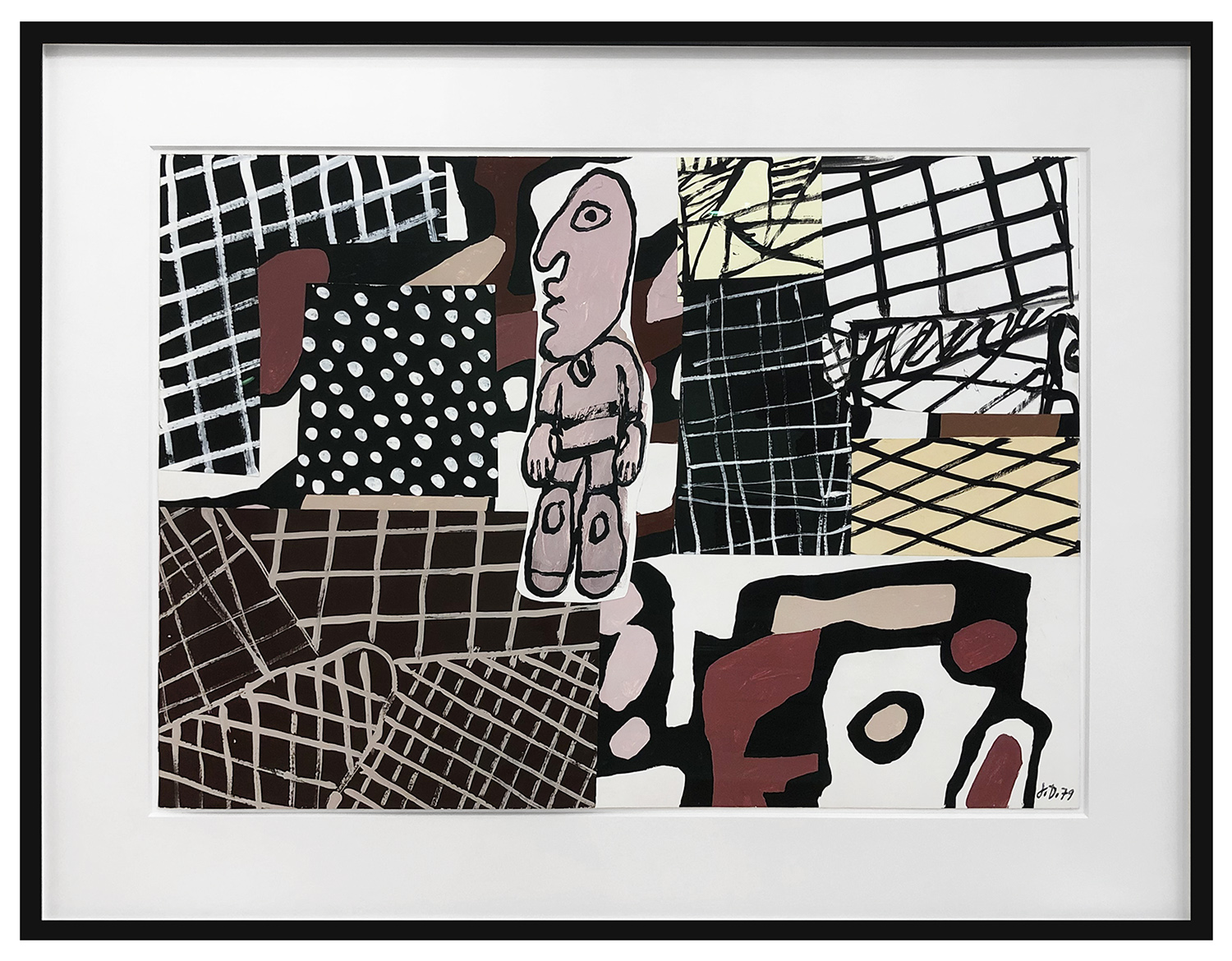
Habitat et usager, August 15, 1979, Acrylic and 8 pieces of collage mounted on canvas-backed paper
“Man’s need for art is absolutely primordial, as strong as, and perhaps stronger than, our need for bread. Without bread, we die of hunger, but without art we die of boredom.”
From February of 1981 until January of 1982, Dubuffet created over 500 works which came to be known as the Psycho-sites. Five of these works, which we recently added to our collection, comprise the focal point of our current exhibition. The first 88 Psycho-sites created by Dubuffet were smaller than the subsequent works. The five in our exhibition are among the initial 88 works. These paintings represent Dubuffets transition back to painting with strong, basic colors and simple representations of forms and beings. Dubuffet created these works practically continuously over the course of a one-year period. It is evident that the paintings are the result of an almost frenzied spontaneity—a stream of consciousness that continued unchecked. The amount of work produced indicates that he painted one or two of these each day during the year he spent creating the Psycho-sites.
Dubuffet described the works this way: “The theme is constantly the same; it is that of a site in which some full-length figures appear in varying numbers in a location (“site”) which could also be said to be very indeterminate: a very general place, of which we cannot say if it is located in the city or the country; in a room or outside.” (Facsicule XXXIV: Psycho-sites, p. 7). These works are redolent of the concepts and motifs of his very early works, but with both more thought and less thought invested by the artist and the viewer. Here is how Dubuffet described this idea: “We can decide—almost everyone does—to consider what our eyes see as incontestable. But, do they see? What is seen passes, at the moment the thought grasps it, through an assimilative grid. What thought receives from it is only an interpretation, a coded translation. We are mistaken when we identify reality with the vision we believe we have of things.” (Facsicule XXXIV: Psycho-sites, p. 7).
When viewing one of the paintings in our exhibit, Site avec 5 personnages (E15), pictured above, on first glance, the viewer notices blocks of bold color. Further examination reveals human forms and vague elements which defy classification. These works seem ideal for a “fantasy of the mind” in which the beholder constructs a spontaneous narrative about the scene depicted in the work. It seems that the artist is challenging us to adhere to his principle that there is no “reality” in art, but only the reality we ourselves create individually. Is the intention to create order out of chaos or just the opposite? It seems Dubuffet wished for us to consider these works on a visceral, spontaneous level: “The colors are crude and trivial; they leave much room for arbitrariness, marked at all times by outrageous impropriety. Impropriety is certainly one of the major recourses to which these works appeal. It puts the mind on alert—forcing it to view through ‘signs’ whose function is uncertain. To get moving, the mind needs food that is not chewed in advance.”
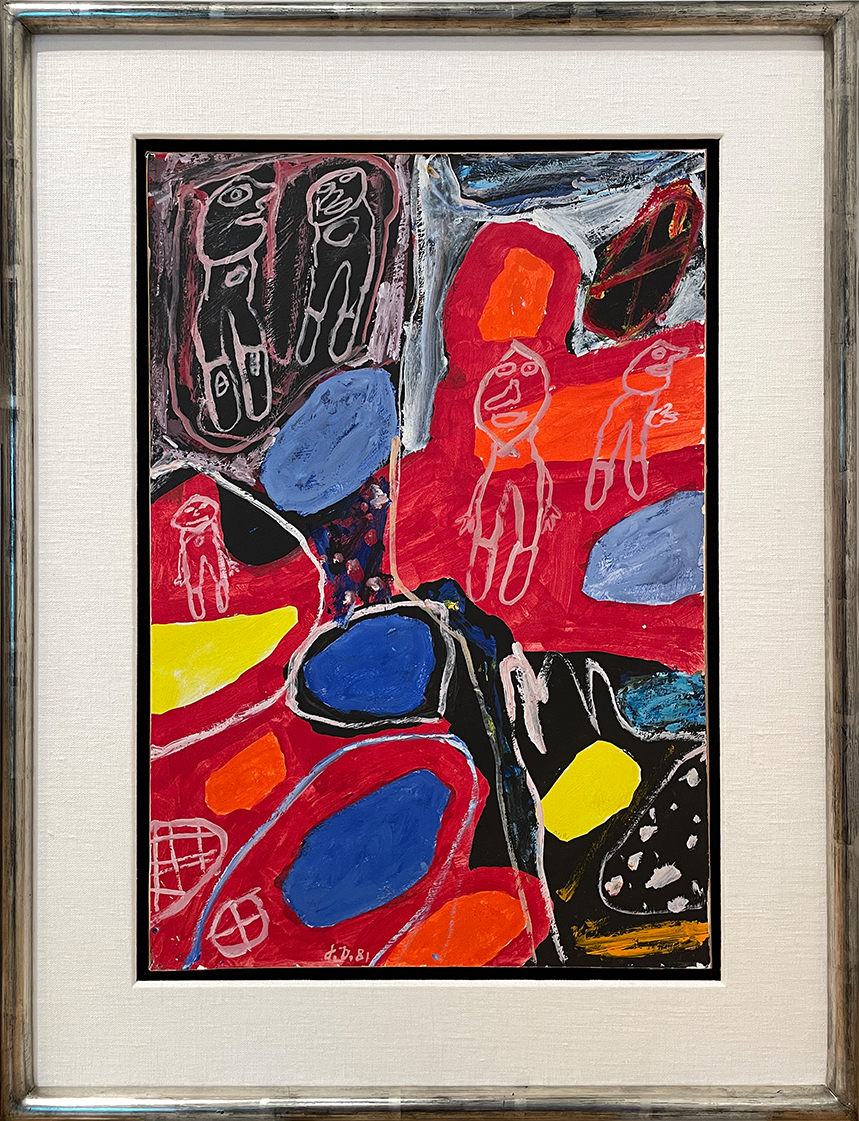
Site avec 5 personnages (E15), 9 février 1981, Acrylic on paper mounted on canvas
“Art is not about imitating the world, but rather about creating a new reality.”
In Dubuffet’s subsequent Mires series which began in February 1983, the artist further extended his attempts to take a renewed perspective of the world. In Mire G 53 (Kowloon), pictured below, the figures have practically disappeared, and the sites are left completely undetermined. Bordering on abstraction, the composition evokes nothing that can be strictly named. The large and the small, lines and curves, voids and volumes mingle, prompting viewers to forget “everything we have been taught to name.”
Dubuffet added the term “Kowloon” to the titles of his early Mires, a reference to the Chinese citadel in Hong Kong (which was later destroyed in the early 1990s). Their vibrant yellow backgrounds are indeed reminiscent of bright Hong Kong store signs and Mandarin procession banners. In addition to the Kowloon paintings, Dubuffet also created Mires with the label “Bolero” which employed white rather than yellow backgrounds.
The entire Mires series was first presented in the French Pavilion at the Venice Biennale in 1984 to critical acclaim. In these works, Dubuffet’s primary concern was a meditation on the mind as central to observation. The resulting paintings are unrestricted, vigorous compositions, dominated by primary blue and red on grounds of yellow or white.

Mire G 53 (Kowloon), 1983, Acrylic on two sheets of paper laid on canvas
“I should decide whether or not there is a reality, I doubt the validity of both the notion of reality and the notion of existing.”
Near the end of his life and career, Dubuffet pushed the limits of the Mires abstractions and created the Non-Lieux works. The literal translation of the term is “non place”.
These works are the quintessential expression of Dubuffet’s lifetime of questioning and exploring the boundaries of art, human perceptions, and existence itself. As with the Mires, the figure has disappeared entirely from the canvas. Additionally, these works distilled the artist’s palette to the bare minimum—sometimes only black and white. They demand that the viewer engage in their own personal interpretation of their meaning.
The Non-Lieux series ultimately served as a foreshadowing of Dubuffet’s departure from the corporeal plane and as a fitting conclusion to a career filled with questioning and philosophical musings presented in the tangible realm of art.
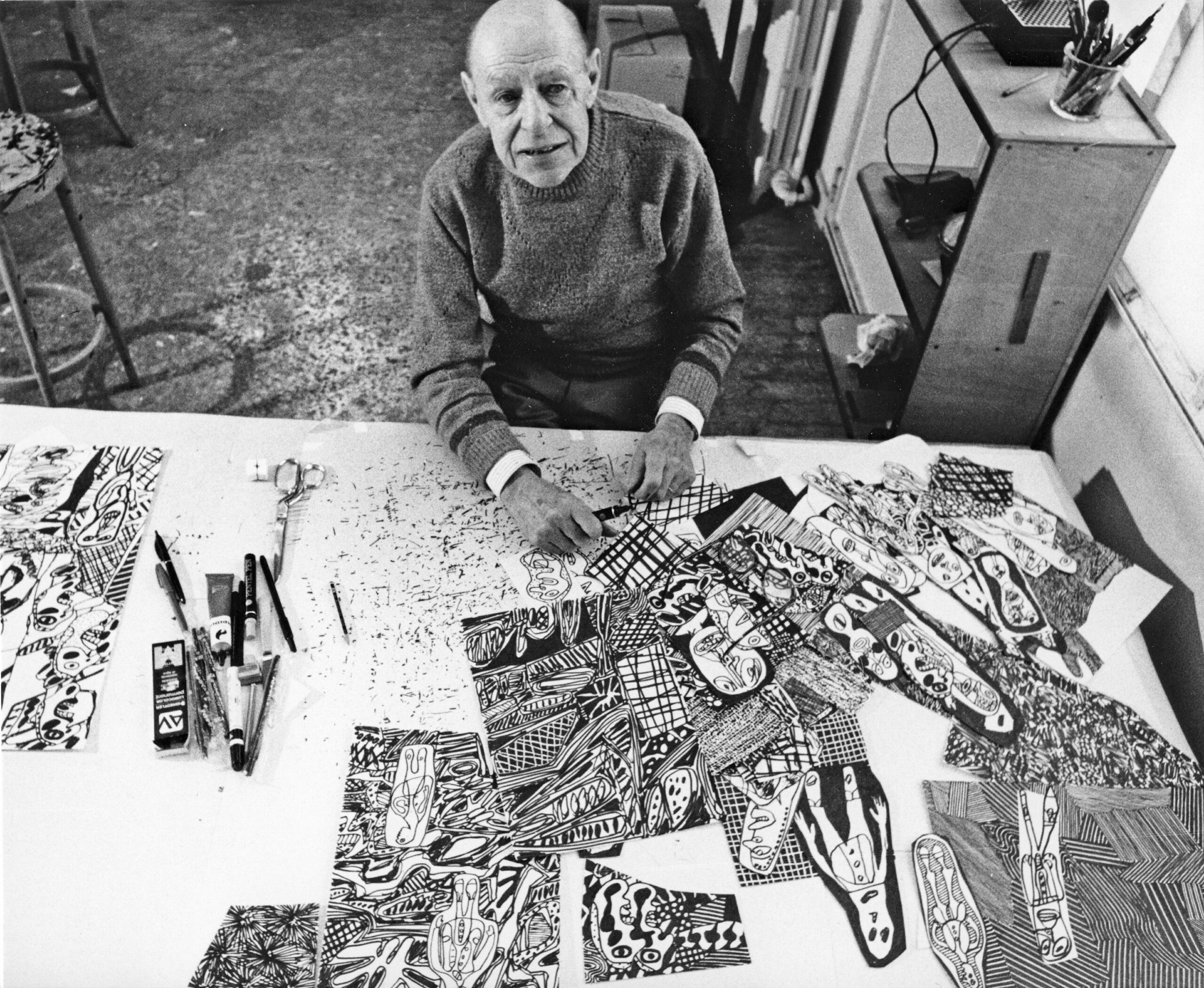
Photo by Kurt Wyss ©️
